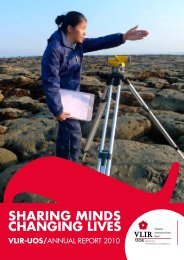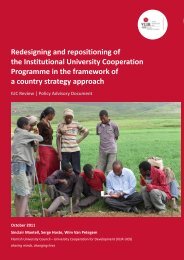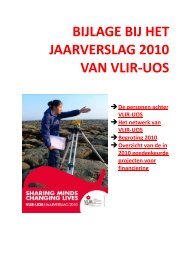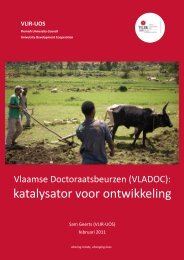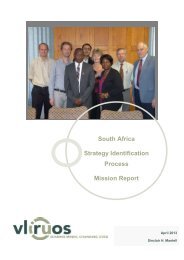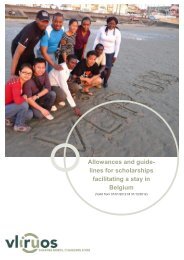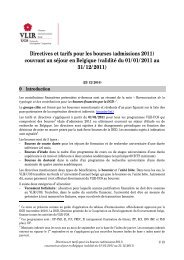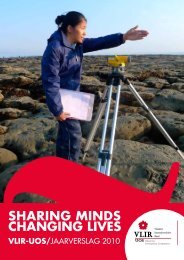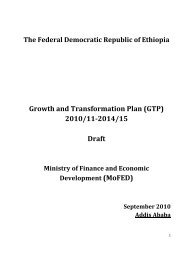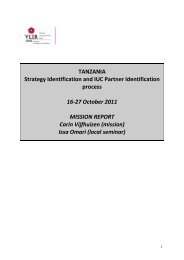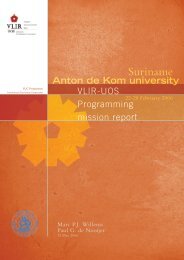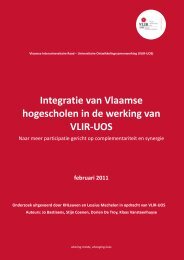Education Sector Development Program - VLIR-UOS
Education Sector Development Program - VLIR-UOS
Education Sector Development Program - VLIR-UOS
Create successful ePaper yourself
Turn your PDF publications into a flip-book with our unique Google optimized e-Paper software.
<strong>Education</strong> <strong>Sector</strong> <strong>Development</strong> <strong>Program</strong> IV<br />
Providing special support programs that can<br />
promote enrollment, retention and performance of<br />
girls<br />
Promoting affirmative action ( e.g. quota for females<br />
during selection and for capacity development)<br />
that can increase the number of female leaders<br />
and teachers in secondary and preparatory schools<br />
Improving the participation of children with special<br />
needs and vulnerability in secondary education<br />
by providing special support such as scholarship<br />
opportunities<br />
Constructing more secondary schools in rural,<br />
underserved areas and emerging regions<br />
Component 4: Involvement of the private sector<br />
and other stakeholders in the expansion of<br />
secondary education deepened<br />
Providing incentives to the private sector to promote<br />
its involvement in secondary school provision<br />
Continuing to implement the cost-sharing scheme<br />
for preparatory secondary education<br />
% of girls that benefit from support programs<br />
% of female leaders and of female teachers at<br />
secondary and preparatory school level<br />
% of children with special needs and vulnerability<br />
with access to secondary and preparatory education<br />
GER, NER, Regional disparity and urban-rural<br />
disparity<br />
The share of enrolment in private schools will<br />
increase to 5% at general secondary level and to<br />
10% at preparatory level.<br />
Number of new private secondary and preparatory<br />
schools<br />
Total earnings from cost-sharing scheme<br />
Adult <strong>Education</strong> with a special focus on<br />
integrated Functional Adult Literacy<br />
1. Situation analysis<br />
The expansion of a comprehensive adult<br />
education system is essential to completing the<br />
learning continuum in Ethiopia, which is central<br />
to improving the quality of life of every Ethiopian.<br />
To this end, the Ministry of <strong>Education</strong> published<br />
in 2008 the National Adult <strong>Education</strong> Strategy<br />
(NAES) of which an integrated approach to<br />
Functional Adult Literacy (FAL) is a major focus.<br />
The concept of integrated FAL has been defined<br />
in the Master Plan for Adult <strong>Education</strong>, which<br />
the Ministry has developed with support from<br />
dvv international but in general terms it seeks<br />
to link writing, reading and numeracy skills to<br />
livelihoods and skills training in areas such as<br />
agriculture, health, civics, cultural education, etc.<br />
Such an approach requires delivery by various<br />
governmental and non-governmental service<br />
providers in multiple settings and also ensures<br />
that literacy skills development is meaningful to<br />
the learners. Many examples establishing such<br />
linkages already exist in Ethiopia, for example<br />
the basic skills/vocational training programs<br />
for youth and adults that are based on market<br />
demand in specific localities and that are linked<br />
to integrated FAL activities and to income<br />
generating and business opportunities (with<br />
the respective business related services). More<br />
bridges however must be built for learners who<br />
wish to access other activities offered by various<br />
providers as they progress through the integrated<br />
FAL process and more post-FAL activities must<br />
be developed.<br />
<strong>Development</strong> of an integrated approach to FAL<br />
is progressing. A national task force composed<br />
of governmental and non-governmental<br />
organizations has helped developing a number<br />
of basic documents on integrated FAL: the FAL<br />
Curriculum Framework; the FAL Implementation<br />
Guideline; the FAL Facilitators Training Manual;<br />
and the FAL benchmarks. FAL provides for a two<br />
year program with yet to be defined yearly skills<br />
targets and curricula that need to be developed<br />
further.<br />
The government acknowledges that statistical<br />
data capturing Adult and Non-formal education<br />
programs is relatively new and accuracy is<br />
inconsistent and uneven. There are many<br />
reasons to explain this situation: there are few<br />
common statistical collection instruments;<br />
programs vary from region to region and<br />
from provider to provider; there is no central<br />
statistical data collection system; and there is<br />
39



